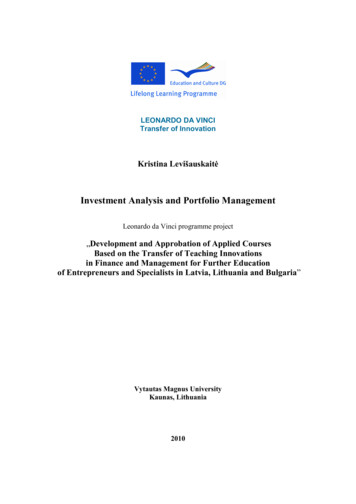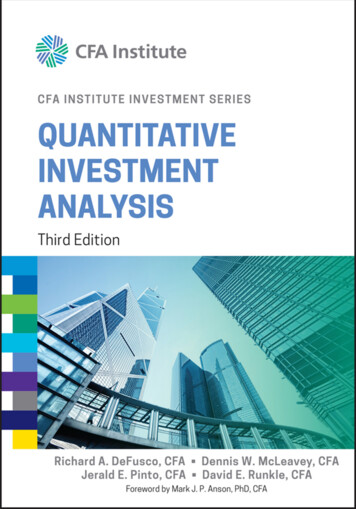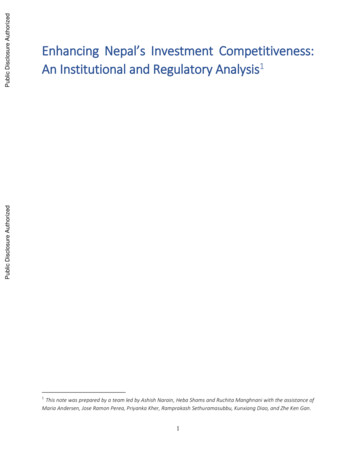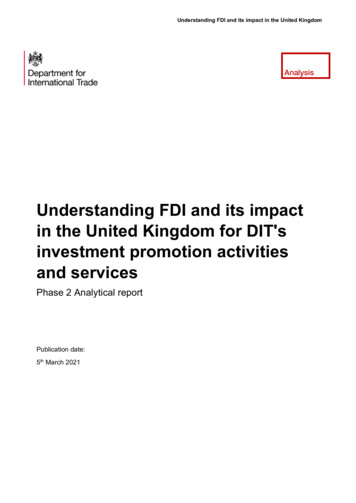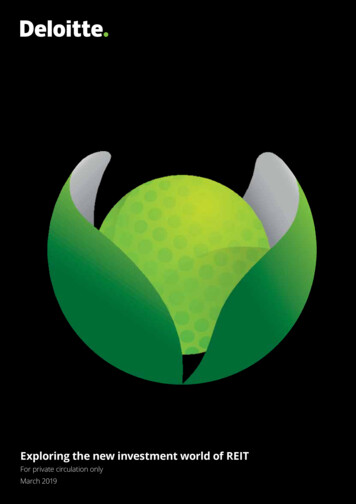
Transcription
Exploring the new investment world of REITFor private circulation onlyMarch 2019
Exploring the new investment world of REITii
Exploring the new investment world of REITContentsIntroduction 2REIT - Regulatory Landscape 7REIT - Tax Landscape 11Comparative Analysis 13Competitive Benchmarking 15Abbreviations 1601
Exploring the new investment world of REITIntroductionWhat is REIT?OverviewReal Estate Investment Trusts (REITs)are companies that own or financeincome-producing real estate in a rangeof property sectors. They provide allinvestors the chance to own valuable realestate, present the opportunity to accessdividend-based income and total returns,and help communities grow, thrive andrevitalise.REITs allow anyone to invest in portfoliosof real estate assets the same way theyinvest in other industries – through thepurchase of individual company stock ora mutual fund or exchange traded fund(ETF). The stockholders of a REIT earn ashare of the income produced throughreal estate investment – without actuallyhaving to go out and buy, manage orfinance property.These companies have to meet a numberof requirements to qualify as REITs.REITs are registered with the Securitiesand Exchange Board of India (SEBI)under SEBI (REITs) Regulations, 2014(the Regulation) as amended from timeto time. It is mandatory for units of allREITs to be listed on a recognised stockexchange having nationwide tradingterminals, whether publicly issued orprivately placed.BackgroundTable: General IntroductionYearCitationREIT TypeREIT Market26 September 2014Securities and Exchange Boardof India (Real Estate InvestmentTrusts) Regulations, 2014(‘REIT Regulations’) – certainmodifications/amendments aremade from time-to-time via pressrelease and notificationsTrustAs of this date, there are no registered Real EstateInvestment Trusts (‘REIT’) in India. In September 2018,draft offer document was filed by Embassy Office Parkswith SEBI A variation of REITs for the infrastructuresector is Infrastructure Investment Trust (InvITs) and,currently, three InvITs have been listed. The move bythe government to allow foreign investments in REITsand rationalisation of the taxation regime is expectedto enable the launch of successful REIT listings in India.Several foreign REITs have, however, been investing inIndian assets over the last decadeSource: Global REIT Survey 20181REIT CategoriesEquity REITsThe majority of REITs arepublicly traded equityREITs. Equity REITs ownor operate incomeproducing real estate.The market and NationalAssociation of RealEstate Investment Trusts(Nareit)2 often refer toequity REITs simply asREITs.Mortgage REITsREITs provide financingfor income-producingreal estate by purchasingor originating mortgagesand mortgage-backedsecurities and earningincome from the intereston these investments.Public non-listed REITs(PNLRs)PNLRs are registeredwith the SEC but do nottrade on national stockexchanges.Private REITsPrivate REITs are offeringsthat are exempt from SECregistration and whoseshares do not trade onnational stock T-Survey Web 20180830 1535727364551.pdf Nareit is the worldwide representative voice for real estate investment trusts—REITs—and publicly traded real estate companies with an interest in U.S.real estate and capital markets. Nareit advocates for REIT-based real estate investment with policymakers and the global investment community.1202
Exploring the new investment world of REITConcept of REITConcept of REIT now exists in several countries worldwide such as Australia, Singapore, Japan, France, UK, etc. For real estate developer - Alternate funding mechanism and provides liquidity For investor – Access to high value real estate and earn steady returnsBased on the global experience, SEBI has introduced REIT regulations in India. The developments are listed below:In 2008 – SEBI initially planned tointroduce concept of REIT in IndiaIn Aug 2014 – SEBI finalised the REITregulations after consulting withstake holdersIn July 2016 – SEBI releasedconsultation paper for amendmentsto the REIT regulations0102In Oct 2013 – SEBI introduced draftREIT regulations in India - Draftregulations have been in line withinternational models0304In Sep 2014 – SEBI released the finalREIT regulations0506In Sep 2016 – SEBI accepted certainchanges in the REIT Regulations.In Dec 2017 – SEBI issuedamendments to REIT regulationsto capture the board meetingdiscussion held on 18 September2017In Nov 2016 – SEBI issuedamendments to REIT regulations0708In Dec 2017 – SEBI board meetinghas approved further amendments09101112In Jan 2019 – SEBI issuedamendment to guidelines on publicissueIn Apr 2018 – SEBI issuedamendments proposed on 28December 2017In Mar 2019 – SEBI board meetingproposed key amendments03
Exploring the new investment world of REITStructure/Value chain stakeholdersREIT will be set up as a Trust under the Indian Trusts Act, 1982.It has to be registered with SEBI.REIT to hold specified assets: Directly or through SPV holding real asset assets; or Invest in SPV which have investments in other SPVs whichsubsequently hold real estate assets (hold co structure)SponsorValuerManagerREITKey stakeholders of REIT Sponsor to set up REIT and appoint trustee Trustees to hold assets on behalf of and for the benefit ofinvestors Manager to assume operational responsibility of REIT Valuer to ensure fair and transparent valuation–– In respect of financial valuation–– In respect of technical asset valuationWhat are assets in which REIT can invest?Eligible Assets/InvestmentsUnit holdersTrusteeSPV Hold CoSPV IReal estateSPV IIReal estateReal estateLimits on HoldingKey Provisions - REITParticulars(Assets that REIT can hold3)Minimum 80% Completed and rent and/or income generating propertiesExcluding vacant or agriculture land or mortgageFollowing considered in the definition of Infrastructure will now be allowed under REIT:–– Hotels, hospitals and convention centeres forming part of composite real estate projects–– Common infrastructure for composite real estate projects, industrial parks and SEZMaximum 20% Under construction properties (including part of existing income generating properties ownedby REIT) which will be held by REIT for at least three years after completion;Completed and not rent generating properties which shall be held by REIT for at least 3 yearsfrom date of purchase;Debt securities in real estate companies whether listed or unlisted,Government securities,Mortgage backed securities,Listed and unlisted equity shares of companies deriving 75% or more income from real estate,Money market instruments and cash equivalents,TDR and unutilised FSI Source: Deloitte analysisWho can invest in REIT?All categories of investors can invest in units of REIT unless restricted by any other regulation governing such investor, whichincludes the following: Mutual funds (within maximum limit) Insurance companies / insurer (subject to certain conditions) Banks (overall ceiling of 20 percent of their net worth permitted for direct investment in shares, convertible bonds/debentures,units of equity oriented mutual funds and exposures to Venture Capital Funds (VCFs) subject to the certain conditions) Strategic Investors 4 such as:–– Infrastructure finance company registered with RBI as a NBFC;–– Scheduled Commercial Bank;–– International multilateral financial institution;–– Systemically important NBFCs registered with Reserve Bank of India; and–– Foreign portfolio investors. Earlier REIT assets means real estate assets and any other assets held by REIT on a freehold or leasehold basis whether directly or through a hold co and /or special purpose vehicle4 Strategic Investor will either jointly or severally invest not less than 5% and not more than 25% of the total offer size.043
Exploring the new investment world of REITWhy invest in REITs?Historically, overseas REITs have delivered competitive total returns, based on high, steady dividend income and long-term capitalappreciation. They are comparatively at low correlation with other assets. This makes them an excellent portfolio diversifier whichhelps in reducing overall portfolio risk and increase returns.Till date, REITs offer investors:01Competitive long-term performance: REITs have provided long-term total returns similar to those of other stocks.02Substantial, stable dividends yields: REITs’ dividend yields historically have produced a steady stream of incomethrough a variety of market conditions.03Liquidity: Shares of publicly listed REITs are readily traded on the major stock exchanges.04Transparency: Independent directors, analysts, auditors, as well as the business and financial media monitor listedREITs’ performances and outlook. This oversight provides investors with a measure of protection and more than onebarometer of a REIT's financial condition.05Portfolio diversification: REITs offer access to the real estate market typically with low correlation with other stocksand bonds.Benefits to the different stakeholdersDeveloper / SponsorInvestors / Unit holdersConverts illiquid assets into liquid listed assetsAttracts investments from retail investors apart frominstitutionsComparatively cheaper source of finance – helpsimproving marginsLiquidity in Real estateManagement and control over assets to continuethrough unitsProfessional management / expertise – comfort onunderlying valueIncome stream to continue – O&M contractsRegulated by authorities – investor protection ensured05
Exploring the new investment world of REITKey Challenges in the REIT ProcessS.NoChallengeParameterDetails1Formation of REIT Identifying the eligible real estate projects which can be transferred toREIT / can be carried out through SPV Evaluating the real estate project and identifyingthe assets and liabilities pertaining to itAdvising on formal structuring of REIT consideringthe accounting, legal, taxation aspects Valuation of the projects Valuation of assets and liabilities Accounting issues Accounting Advisory Services,Assistance in preparation of opening BalanceSheet for REITSetting up of Ind AS Accounting Policies andReporting FrameworkEnabling process of consolidation of multiple SPVsof REIT 2Listing of REIT Pre-requisites for IPO Carrying out the IPO process Post IPO formalities Advising on pre-IPO compliance such as minimumvaluation of assets and liabilities, percentage ofoffer and allotment, offer document disclosures,etc.Evaluating the IPO and private placement optionsEvaluation of internal control and Related PartytransactionsTax considerationsAssistance in preparation and restatement of IndAS financial statements required for past 3 yearsand other financial information required in theoffer document as per the RegulationsDue Diligence SupportOngoing corporate law complianceTax considerationsAdvising on post issue compliances – investmentconditions, dividend policy, borrowing limits,valuation, board structure, meetings, filing ofdocuments with SEBI and Stock exchange, etc.Assistance in setting up of half yearly andannual financial reporting process and relateddisclosures for REIT for going forward complianceTax considerationsSource: Deloitte analysisMarket Trends in IndiaBlackstone partners with the Embassy Group to launch India's first REIT5In September 2018, Embassy Office Parks (a joint venture of US private equity firmBlackstone Group and Embassy Group) filed draft offer document with the Securities andExchange Board of India (SEBI) proposing to raise over INR 5,000 crore through REIT.The move has made the Blackstone-Embassy REIT the first of its kind in not only India, butin Asia as well and the largest in terms of office portfolio area, more than twice the size ofothers in the continent. With this, India will join the league of global REIT markets such asthe US, the UK, Singapore, Japan Australia and Canada. Embassy Office Parks will list 33million square feet of office real estate portfolio under REIT.6 securities-india-private-limited/ jcr content/par/linklist a1aa/link MvRVBETF9EUkhQLnBkZg /EPDL DRHP.pdf6 65927273.cms506
Exploring the new investment world of REITREIT - Regulatory LandscapeIntroductionThe REIT regulations came into force in September 2014. The purpose was to set a regulatory regime, which could alleviate thedebt and the liquidity crisis plaguing the real estate industry. The objective was to monetise existing unsold inventory of realestate and make it a revenue generating asset under the REIT model.Key Provisions – Sponsor / Sponsor GroupParticularsProvisionsWho can be a sponsorAny person – any body corporate / individualNumber of sponsorsNo limit specified - Each sponsor to hold not less than 5%Eligibility criteria On collective basis – Rs 100 cr andMinimum net worth / net tangible Each sponsor – Rs 20 crassetsExperienceSponsor has no fewer than 5 years experience in Development of real estate with at least two completed projects or Fund management in real estate industryLock in requirements after listing Initial Hold at least 25% of total units after initial offer on a post issue basis for minimum threeyears Units exceeding 25% of total units shall be held for minimum one year Unit holder other than sponsor shall hold units for at least one year from the date oflistingContinual (at all times) On collective basis hold not less than 15% of units Each sponsor individually to hold not less than 5% of outstanding unitsRe-designated sponsorAllowed to sell units to another sponsor subject to satisfaction of following: Holding for three years from date of listing and Conditions with respect to holding at all timesSource: Deloitte analysis07
Exploring the new investment world of REITKey Provisions – ManagerParticularsProvisionsWho can be a ManagerCompany or LLP or body corporate incorporated in IndiaEligibility criteria Minimum net worth / nettangible assets Experience10 CrManager or its associatesNo fewer than five years experience in Fund management or Advisory services or Property managementin real estate industry or in development of real estateEmployeesAt least two employees having minimum five years’ experience in above areasGoverning body Minimum 50% of members to be independent and not director or member of anotherREITSource: Deloitte analysisKey Provisions – Investment CriteriaParticularsProvisionsCompleted and rent / revenuegenerating assetsMinimum investment of 80% of value of assets in completed and rent generating propertiesOther specified assetsMaximum investment of 20% in other specified assets (including under construction assets /projects)Number of projectsREIT can hold single asset/projectInvestment through SPV Hold Co/ SPVREIT should hold at least 50% in equity share capital of the SPV Hold Co/SPV. REIT may investin properties through SPV Hold Co, such that the ultimate holding interest of REITs in theunderlying SPV is not less than 26%% of revenue and assetsNot less than 51% of revenue of REIT, SPV Hold Co and SPV, other than gains arising fromdisposal of properties, will be generated from rent, leasing, and letting real estate assets /income incidental to leasing of such assets.Lending by REITREIT will not undertake lending to any person except Hold Co / SPV in which it has alreadyinvested. Further, investment in debt securities will not be considered as lendingOthersREIT cannot invest in units of another REITCompleted and not rent generating properties which shall be held by REIT for at least threeyears from date of purchaseSource: Deloitte analysisKey Provisions - Issue & listing of unitsParticularsProvisionsMeans of raising funds Value of REIT assets prior toinitial offerMinimum Rs 500 cr of REIT assets (including held by Hold Cos and SPVs)Minimum initial offerRs 250 crInitial offerFollow on offer, qualified institutional placement, rights issue, bonus issue, offer for sale.Preferential issueMinimum investment by investor Rs 0.02 crListing of unitsYes – Units to be mandatorily listedMinimum number of investors200 investors (maximum investor not specified)(other than Sponsors/Sponsor Group/Related Parties/Associates)08
Exploring the new investment world of REITParticularsProvisionsMinimum public floatPost issue REIT Capital Rs 1,600 cr – At least 25% of total unitsPost issue REIT Capital from Rs 1,600 cr to Rs 4,000 Cr - At least Rs 400 CrPost issue REIT Capital Rs 4,000 cr & above – not less than 10% of total unitsNature of investorBoth resident and non-resident investors are permitted to investMinimum subscription90% of issue sizeMinimum trading lotsRs 0.01 CrCategories of InvestorMutual FundsAll categories of investors can invest in units of REIT unless restricted by any otherregulations governing such investor. SEBI has allowed mutual funds to invest in units of REITsubject to following maximum limit: 10% of a mutual fund scheme’s NAV in units of REIT; and 5% of mutual fund scheme’s NAV in units of REIT by a single issuer; and 10% of units issued by a single issuer of REIT (collectively for a mutual fund under all itsscheme).Insurance CompaniesIRDA has allowed insurance companies / insurer to invest in units of REIT subject tofollowing conditions: Maximum investment can be 3% of fund size of insurer or 5% of units issued by a singleREIT No investment can be made in REIT wherein promotor group of insurer is a sponsorBanksRBI has allowed banks to participate in REITs within the overall ceiling of 20% of their networth permitted for direct investment in shares, convertible bonds/debentures, units ofequity oriented mutual funds and exposures to VCFs subject to the following conditions: Bank should put in place a Board approved policy on exposures to REITs which laysdown an internal limit on such investments within the overall exposure limits in respectof the real estate sector Bank will not invest more than 10% of the unit capital of an REIT Banks should ensure adherence to the prudential guidelines issued by RBI from time totimeParticipation by StrategicInvestors (“STI”)A REIT can invite subscriptions from the STI not less than 5% and not more than 25% of thetotal offer size.The price at which the units will be subscribed by STI will be not less than or more than theissue price determined in the public issue.Units will be locked-in for a period of 180 days from the date of listing in the public issue.Offer for sale by existing UnitHoldersUnits can be offered for sale to public if such units are held by existing unit holders for aminimum period of one year prior to filing of draft offer with SEBI. However, holding periodfor the equity shares (including compulsorily convertible securities) or interest in SPVagainst which units to be issued shall also be considered for the period of one yearInitial Offer or Follow on OfferWithin a period of one year from the date of issuance of observations by SEBITimelines for listingTo surrender its certificate if REIT fails to make its initial offer within three years ofregistration subject to extension of one year by SEBIDebt SecuritiesA REIT whose units are already listed, may issue debt securities in the manner specified bythe SEBI, provided that debt securities shall be listed on recognised stock exchange(s)Source: Deloitte analysis09
Exploring the new investment world of REITKey Provisions – Distribution ConditionsDistribution of Net distributablecash flows*ProvisionsSPV to SPV Hold Co/REITAt least 90% of net distributable cash flows of SPV to be distributedSPVHold Co to REITThe SPV Hold Co to distribute 100% cash flows it receives from underlying SPV. In case of cashflows generated by the SPV Hold Co on its own, at least 90% to be distributedREIT to unit holdersAt least 90% of net distributable cash flows of REIT to be distributedSurplus on Sale of propertyIf reinvested – No distribution to unit holders required;If not reinvested within one year – Distribute 90% of sales proceedsPeriodicity of distributionsOnce in every six monthsSource: Deloitte analysis (Note: * Subject to applicable provisions of the Companies Act, 2013 or the LLP Act, 2008)Key Provisions – OtherParticularsProvisionsRelated party Borrowings and deferredpayments Related party transaction shall be on arms length basisTransaction deemed as related party between two or more REITs with common manageror sponsor or associated of manager or sponsorStringent disclosure requirementsApproval from unit holders may be required in certain casesAggregate consolidated borrowings and deferred payment of REIT net of cash and cashequivalents shall never exceed 49% of value of REIT assetsValuation of assets Periodic valuation norms specifiedDefinition of Valuer Valuer definition aligned with the definition of ‘Registered Valuer’ as defined underSection 247 of the Companies Act, 2013 or as specified by the BoardSource: Deloitte analysis10
Exploring the new investment world of REITREIT - Tax LandscapeTable: Tax ConsiderationsAt the time of formationScenarioTax ImpactExchange of shares of SPV withunits of REITNeither capital gains nor MAT applicable in the hands of sponsorExchange of real estate assetsCapital gains taxable at applicable rates in the hands of sponsorwith the units of REIT or for cashconsiderationUnresolved IssueExemption from capital gains on swap of assets against the units of REITSource: Deloitte analysisTaxation in the hands of SPVParticularsTax ImpactInterest Taxable deductible for SPVNo withholding on upstreaming interest income to REITWithholding applicable on upstreaming interest income to SPV HoldcoRental income Rental income subject to tax as business income or income from house propertyDividend DDT will not be payable by SPV for dividends paid to REIT (Subject to 100% held by REIT)In case of dividend distribution to SPV Hold Co, DDT shall be paid by SPVSale of real estate Subject to Capital Gains TaxUnresolved Issue Exemption from DDT on distribution of dividend by SPV to SPV Hold CoSource: Deloitte analysisTaxation in the hands of SPV Hold CoParticularsTax ImpactInterest Interest earned from SPV is taxable at applicable ratesNo withholding on upstreaming interest income to REITRental income Taxable at applicable ratesDividend Exempt for dividends received from SPVDDT will not be payable by SPV Hold Co for dividends paid to REIT (Subject to 100% heldby REIT)If SPV Hold Co is not held 100% by REIT, DDT payable by SPV Hold Co would be net ofDDT paid by SPV provided if SPV is subsidiary of SPV Hold Co and dividend is paid in thesame year) Sale of real estate Subject to Capital Gains TaxSource: Deloitte analysis11
Exploring the new investment world of REITTaxation in the hands of REITParticularsTax ImpactInterest / Rental Income Interest income / Rental income exempt in the hands of REITREIT required to withhold tax from payments to unit holders:Residents: 10%Non-residents: 5%, benefits under DTAA, if any, shall be applicableDividend Exempt, however, implications under section 115BBDA needs to be consideredGains on transfer of SPV share orreal estate/ infra assets Subject to Capital Gains TaxSource: Deloitte analysisAt the time of exit by UnitholdersScenarioTax ImpactOn transfer of unitsChargeable to Capital Gains Tax at applicable rates depending on long or short in nature12
Exploring the new investment world of REITComparative AnalysisPotential opportunity aheadREIT versus AIFReal estate developers require funds on an ongoing basis todevelop and bring their land parcels into the market.SEBI has allowed Alternative Investment Funds (AIFs) to setup in India under a newly formulated route. The route allowspooling of funds for investments in areas such as real estate,private equity and hedge funds.AIF, as an investment vehicle, will offer necessary growthcapital to the real estate sector. Since the Indian bankinglaw does not allow lending to real estate developers for landpurchase (basic raw material for development), AIFs will offernecessary capital for the development of key sectors suchas housing, commercial and retail. They will also be able tochannelise money (under SEBI guidelines) for development ofthe sector.7With bank lending getting tighter and PE funds desertingthe cash strapped realty sector, developers preferredto set up Alternative Investment Funds (AIFs). Accordingto AIF guidelines, real estate funds fall under category 2and 3. Currently, category 2 and 3 funds are managing acommitment of over INR 5,000 crores.Given the differentiators, the market is expected to see both,AIFs and REITs, co-existing in India.Table: REIT versus AIFParticularsREITAIFListing Mandatory listing until delisted Units may be listed only after final close of thefund or scheme. Angel funds (‘AFs’) cannot belistedTenure Unlimited Fixed tenure for all AIFs. AIF III can also be openendedInvestment in oneasset / company More liberal investment norms Max limit prescribed - 25% of corpus (AIF I and II)and 10% for AIF IIIBorrowing Aggregate borrowings not to exceed 49% ofvalue of REIT assets (including SPV) AIF I and II not permitted to borrow except fortemporary funding subject to conditions. AIF IIIpermitted subject to conditions. No restriction atinvestee companyTaxation status Pass through only for interest income andrental income Pass through for Category I and Category II AIFSource: Deloitte ernative/67131.html13
Exploring the new investment world of REITREITs will be managed by Trusts following real estate specificguidelines. Thus, it will ensure that investor interests in theassets/investments, are well-guarded. REITs will offer an exitopportunity to AIFs invested in real estate through listings. Thiswill help AIFs to churn money faster and re-invest the sameback into the market. Thus, by REITs offering exit routes andcapital churning mechanisms, investors will be keen to invest inreal estate through AIFs.REIT versus Real Estate Fund8Both the real estate funds and REITs are used to diversify along-term investment portfolio.A real estate fund is a type of mutual fund that primarilyfocuses on investing in securities offered by public real estatecompanies. The majority of real estate funds are investedin commercial and corporate properties. These includeinvestments in raw land, apartment complexes and agriculturalspace. This type of fund can invest in properties directly orindirectly through REITs.Meanwhile, a REIT is a corporation, trust, or association thatowns or finances income-producing real estate.Table: REIT versus Real Estate FundParticularsREITReal Estate FundAdvantages Disadvantages Lower investment entry costsOffers a liquid method of investing in realestateFlexible and allows investors to invest ina range of real estate from commercialproperties to shopping malls Do not provide long-term capital appreciation Real estate funds that invest in mortgage REITsprovide higher yields than real estate funds thatinvest in equity REITsReal estate funds that are not invested in REITscan offer capital appreciation and fund valueappreciationDo not provide long-term capital appreciationSource: Deloitte ate-fund.asp
Exploring the new investment world of REITCompetitive BenchmarkingGlobal Real Estate InvestmentMajor geographies implementing REITThe United States (US) is the largest listed realestate market. Further, the listed real estatemarket is increasingly becoming global. The appealof the US REIT approach to real estate investmentis driving the growth of the market. Currently,more than 35 countries have REITs, including all G7countries.9More than 35 countries have adopted the US-basedREIT approach to real estate investment offering allinvestors access to portfolios of income producingreal estate globally. Mutual funds and exchangetraded funds offer the easiest and most efficientway for investors to add global listed real estateallocations to portfolios.Countries and Regions that Have Adopted the U.S. REIT d2009Greece Hong 993Malaysia2005Bulgaria Costa Rica20052009Hungary2011Mexico Netherland20101969Pakistan Philippines zaniaSingapore1999Turkey1995Vietnam2015Table: REIT Worldwide - Key GeographiesParticularsUnited KingdomUnited StatesCapital requirements Minimum capitalisation of SGD300 millionSingaporeNo capital requirementNo capital requirementListingrequirementsMandatory listingNo listing requirementMinimum number of REIT denominated in SGD – 25%investorsof share capital to be held by min500 subscribers.35% public floatAt least 100 shareholders. Furtherfive or few individuals cannot hold 50%Non-residentinvestorPermitted to investPermitted to investPermitted to investForeign assetsInvestment permittedInvestment permittedInvestment permitted subject toconditionsDistributionrequirementTo avail tax concession 90% oftaxable income to be distributedAt least 90% of rental profits to be At least 90% of taxable income todistributedbe distributedListing required for taxconcessionsSource: Deloitte analysis basis secondary research (the information above is not from primary source therefore requires sign off from respectivejurisdiction experts)9https://
2 Nareit is the worldwide representative voice for real estate investment trusts—REITs—and publicly traded real estate companies with an interest in U.S. real estate and capital markets. Nareit advocates for REIT-based real estate investment with policymak


